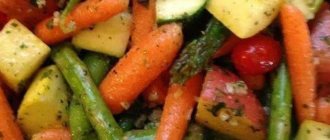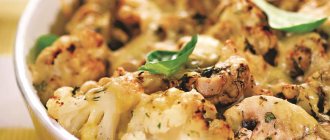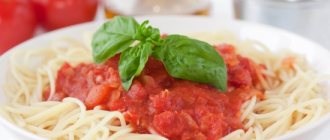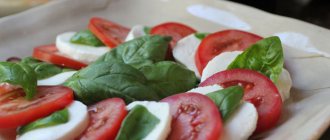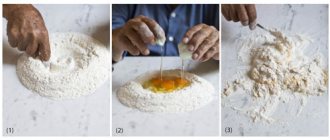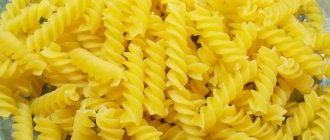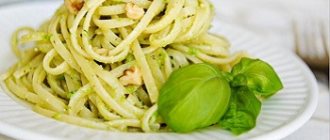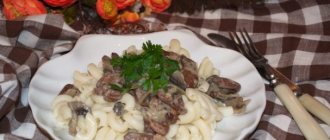Real Italian pasta with tomatoes and basil is accessible to anyone - even if not particularly experienced in cooking, but definitely has the necessary products on hand. Of these, a noticeable Mediterranean note is present only in olive oil, and all other ingredients, including basil, are quite international and can be found in any grocery market.
Pasta prepared in this way (spaghetti or other long pasta) gives you a feeling of fullness and vigor at the same time, because in addition to calories, they contain a lot of vitamins. And the basil present promotes digestion, so after this dish there is no feeling of heaviness in the stomach.
Nutritional value per serving
These are thin, round in cross-section, similar to sticks or ropes (twine) dough products.
The best tomatoes are in the summer, starting in May, when you can buy Uzbek and Azerbaijani tomatoes in the markets, and until October-November, when our Moscow tomatoes ripen and also become sweet and fleshy.
Cheese has a thousand-year history, although it is still unknown exactly which region is the birthplace of this delicious fermented milk product. Presumably, the place of his birth can be considered the Middle East, where Bedouin nomads transported milk in leather bags and were the first to notice that shaking and heat did not spoil it, but turned it into cheese.
Lemon is the fruit of the lemon tree, belongs to the large family Rutaceae, and is a close relative of lime, orange, kumquat, tangerine and other citrus fruits.
It is no coincidence that basil is called the royal herb - its leaves and the entire above-ground part are distinguished by a pleasant aroma and piquant delicate taste.
Garlic is a plant from the onion family with a pungent taste and specific smell.
Olive oil is a traditional part of the Mediterranean diet, and populations where olive oil is a common everyday staple enjoy longevity and excellent health.
Description of preparation
Spaghetti with tomatoes and basil is prepared very quickly and very simply. To begin with, large tomatoes are doused with boiling water (or blanched), after which the skin is removed, the pulp is cut, removing the seeds.
There is no point in crushing or grinding the tomatoes; this sauce assumes just such a seasoning texture – stewed pieces.
Fried in a frying pan with heated olive oil with the addition of garlic, and then chopped hot pepper into small rings. The basil is torn off the stem (we will leave some for decoration) and finely chopped.
Although many chefs claim that the characteristic garlic amber disappears during heat treatment, it is better not to risk it and prepare such a breakfast not immediately before a business meeting.
As for the chili pepper, after you have cut it in half, removed the middle and chopped it, you need to wash your hands very carefully. If you inadvertently scratch your nose or eyes with unwashed hands, you will get a burning sensation in the mucous membranes, swelling of the nose and eyes, tears and a runny nose for a while.
The classic version of this dish is to first add the bulk of basil and finely chopped leaves to a frying pan with tomatoes and garlic. And then, when the pasta is ready, when serving, cut small tomatoes and a couple of basil leaves are laid on top of the pasta.
Spaghetti with tomatoes and basil - fast, tasty, healthy!
Real Italian pasta with tomatoes and basil is accessible to anyone - even if not particularly experienced in cooking, but definitely has the necessary products on hand. Of these, a noticeable Mediterranean note is present only in olive oil, and all other ingredients, including basil, are quite international and can be found in any grocery market.
Pasta prepared in this way (spaghetti or other long pasta) gives you a feeling of fullness and vigor at the same time, because in addition to calories, they contain a lot of vitamins. And the basil present promotes digestion, so after this dish there is no feeling of heaviness in the stomach.
Ingredients
The recipe includes (for four servings):
- 500 g long pasta (spaghetti, tagliatelle, fettuccine).
- 6 large fleshy ripe tomatoes.
- 15 small tomatoes (cherry, cocktail).
- Small hot pepper.
- Garlic (head).
- 10 sprigs fresh basil.
- 6 tbsp. l. olive oil.
As in all Mediterranean dishes, add salt and freshly ground black pepper to taste, and a little mixture of herbs. You can pepper the pasta with ground “Mixture of Five Peppers”, with which basil is in perfect harmony.
How to prepare and store tomato paste
Let's discuss some nuances and tips on how to prepare and store tomato paste with basil. We need aromatic and fairly sweet ripe tomatoes. This is a great sauce with minimal ingredients and very easy to make.
This dish tolerates freezing well, which means we can prepare tomato paste with basil for the whole winter and use it when we need it. If you decide not to freeze the pasta, then keep in mind that you need to store it in a hermetically sealed package and strictly in the refrigerator - since the dish contains no vinegar, a very small amount of salt and sugar - that is, few preservatives.
The highlight of this recipe is the fresh basil greens - they are very tender, so do not cut them with a knife - tear the leaves with your hands or use them whole, simply separating them from the stem. There is no need to cook the basil - we put it in the prepared dish, immediately turning off the heat.
For those who don't really like basil, use your favorite herb - be it cilantro, oregano or parsley. In some variations, wine or apple cider vinegar is added to this tomato paste, but this is not strict, so listen to your taste and enjoy cooking what you like. Bon appetit!
Step-by-step recipe for tomato paste with basil
We prepare the vegetables - wash and peel the tomatoes. Grind the garlic cloves to a pulp. Using a blender, grind the ripe tomatoes; if desired, you can pass them through a sieve. Wash, dry and separate fresh basil leaves from the branches.
In a thick-bottomed saucepan or deep frying pan, heat the olive (or other vegetable) oil over medium heat. Place well-chopped garlic in hot oil and fry it, stirring constantly, for literally 2-3 minutes.
Add tomatoes to the resulting garlic oil and mix. Now add the spices - ground black pepper, red pepper, sugar and salt - mix everything thoroughly. Stirring the dish at least every 5 minutes, continue cooking until the mass thickens - about 20-30 minutes.
A minute before readiness, add chopped or whole fresh basil leaves to the tomato paste, mix gently and turn off the heat. Our sauce is ready, remove the pan from the stove and let it cool to room temperature, after which we pour it into plastic containers for freezing and long-term storage - up to 4 months, or into a convenient glass container for storage in the refrigerator for no more than a week.
In creamy sauce with basil
The main success of pasta lies in the properly prepared sauce. It should completely fit into the concept of the dish, emphasizing and complementing the taste of individual ingredients. Tender and light pasta with basil in a creamy sauce is a delicious dish of Italian cuisine that will delight all family members. Do you want to diversify your daily menu and make it even tastier? Then take note of the recipe and start creating!
Ingredients:
- Paste (any shape) – 300 g;
- Butter – 50 g;
- Cream 20% – 200 ml;
- Flour – 1 tbsp;
- Basil – 5 sprigs;
- Hard cheese – 100 g;
- Nutmeg – ½ tsp;
- Freshly ground black pepper - to taste;
- Salt - to taste.
Pasta in creamy sauce with basil and cheese will be ready in less than half an hour. It’s hard to imagine a more appetizing and easier to prepare dish.
Preparation:
- Wash the basil, shake off the water and tear off the leaves. Finely chop, leaving a few leaves for decoration.
- Melt the butter in a deep saucepan and combine it with flour. Fry lightly, pour in the cream and, stirring with a whisk to prevent the formation of lumps, cook the sauce until thickened.
- A few minutes before the end of cooking, add basil, nutmeg, salt and pepper to taste.
- Cover the sauce with a lid to let it sit while the pasta cooks.
- Boil the pasta in boiling salted water, following the instructions on the package, but undercook for 1-2 minutes.
- Drain the water and place them in a colander. No need to rinse.
- Grate the cheese on a fine grater.
- Transfer the pasta to a saucepan, stir and heat the dish for just a couple of minutes over low heat.
Divide the hot pasta in the creamy basil sauce into bowls and top generously with grated cheese. And of course, a glass of good Italian wine would not be amiss when serving.
Product selection
According to the recommendations of Italian cuisine, fresh tomatoes of any variety can be used for pasta, and if they are unavailable, tomato paste or sauces can be used. Many chefs prefer to use cherry tomatoes - despite their small size, they are very juicy and tasty.
To prepare hearty and spicy spaghetti with tomato sauces and basil, you can use fresh or dried herb leaves. This does not affect the taste of the finished dish.
Pasta made from durum wheat is most suitable for Italian pasta. They not only retain their shape well and do not boil over, but are also healthier.
Tomato and basil sauce for spaghetti
A spicy tomato and basil sauce can be called universal - it goes well with pasta, meat dishes, and cereals. Once prepared, it can be stored on the refrigerator shelf for 2-3 days. Required Products:
- fresh tomatoes – 500-600 g;
- basil – 5-6 sprigs, garlic cloves – 3 pcs;
- olive oil – 3 tbsp. l, granulated sugar and salt - 1 tsp each;
- ground paprika, coriander, black or pink pepper - 1 tsp each.
Preparation:
- The tomatoes need to be scalded, peeled, and pureed in a blender to obtain a puree.
- Fry chopped garlic cloves in hot vegetable oil, but no more than 1 minute.
- After this, add tomato puree to the garlic, sprinkle with sugar, salt and bring to a boil. Be careful not to allow the spicy sauce to bubble.
- After 10-13 minutes, add chopped basil and spices to the pan, mix everything thoroughly and leave on the stove for another 10 minutes.
The finished sauce is served with spaghetti and other pasta, cereals, potatoes and meat dishes.
A little about pasta
Italian children are praised when they eat pasta, just like I was praised for soup as a child. This is the first dish and almost the most important part of the diet in Italy. I also love pasta and usually cook it for lunch.
It's convenient and quick: the sauce can be made while the water is boiling and the pasta is cooking. But it’s better to note the cooking time, because leaving tagliatelle or penne in boiling water is a fatal mistake. Overcooked pasta will not absorb the sauce, and the hard center, that same “al dente” state, is a guarantee that you have prepared a slow carbohydrate that will give you a feeling of fullness for hours, not minutes.
Barilla even has playlists on Spotify dedicated to different types of pasta - spaghetti, fusilli, linguine. The music plays exactly as many minutes as it takes for the product to become “al dente”.
A more complicated nuance is the correct combination of sauce and pasta. It is better to stick to authentic combinations: they are time-tested and set the taste of the dish. For example, Carbonara requires spaghetti, and Bolognese, which in Italy is called “pasta al ragu,” requires tagliatelle. If the required paste is not available, you can focus on the size and replace the short and long paste with analogues. Linguine can still pass for spaghetti, but farfalle is unlikely.
The third Italian rule is not to add grated cheese to pasta that contains fish. Some restaurants do this, but these are usually tourist places. Italians don’t approve of this, and to the argument “Jamie Oliver did it!”, they simply answered me: “He’s British.” But, in the end, if you like it this way, I don’t see any reason not to trust your feelings (except for possible stomach upset!).
All the dishes below are traditional recipes that may differ slightly in different regions or even families. This is not to say that any of them are more “Italian” than others. This is approximately the same as in Russia with the recipe for borscht - each family can have its own.
